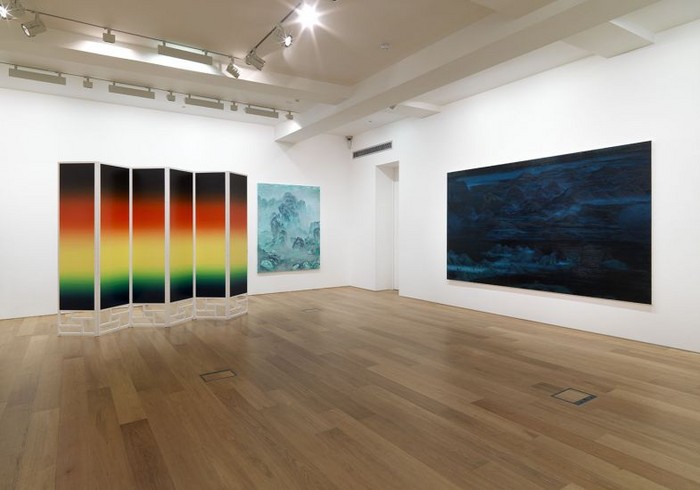Christian Hidaka (formerly Ward)
13 Jan - 19 Feb 2011
CHRISTIAN HIDAKA (FORMERLY WARD)
Waterfall at the Top of the River
13 January – 19 February 2011
We slip into Tientai caves,
Home is a hole,
And a hole’s where nothing is.
We visit people unseen -
Chewing magic mushrooms,
Underneath tall pines.
We talk about the past and present,
And sigh at the world gone mad. - Shih Pe (9th century)
Waterfall at the Top of the River is a series of immersive meditations on a fictitious landscape based on the Japanese island of Yakushima. Waterfalls, rocks, mountains and skies form a cosmos of bright, colourful textural spaces, waiting to be drawn back into black holes. Through a saturated display of historical conventions found in both Eastern and Western landscape painting, Hidaka’s practice creates a sense of both harmony and dissonance, linking a specific landscape and abstract painting practice, consciousness and image.
Waterfall at the Top of the River re-articulates the gallery space, leading the viewer from behind a Japanese screen into a dramatic large-scale painted and imagined representation of Yakushima’s morphology. Three large paintings dominate, depicting the waterfalls of the title, with misty spirals and cavelike holes in hillsides leading to places of no return...
The title of the show is taken from the closing lines of a talk given by psychedelic writer Terence McKenna at the Esalen Institute, California in 1993, reflecting on the potential for landscape painting to evoke the psychology of human experience. McKenna played a crucial role in the resurgence of psychedelics for a younger generation during the nineties. His influence can be extended to Hidaka’s practice as a whole, and resonates especially with works in Waterfall at the Top of the River.
Christian Hidaka is known for a distinctive visual vocabulary made of broad brush-strokes saturated by Technicolor palettes, recalling psychedelic design culture over the past forty years. His landscape paintings depict archaic and futuristic landscapes that combine styles and narratives whose conventions are partly inherited from Japanese prints.
For Waterfall at the Top of the River the artist and Max Wigram Gallery have published a fully illustrated booklet featuring essays by Yves Brochard, Roger McDonald and David Waterworth.
Christian Hidaka (formerly Ward) was born in 1977 in Noda, Japan and lives and works in London. In 2010 Hidaka had a solo show at Michael Rein, Paris and was selected for The Library of Babel at 176 Gallery, London. Group shows in 2009 included Eat-me, Drink-me, Goss-Michael Foundation, Dallas and Elements of Nature at the Weisman Art Museum, California. In 2008 he was part of the Beijing Biennale and Imaginary Realities at Max Wigram Gallery.
Terence McKenna wrote about psychedelic drugs, their role in society and existence beyond the physical body, but whose interests spanned ethno-botany, environmentalism, shamanism, mysticism, biology, geology and physics. McKenna’s use of plant-based entheogens (psychoactive substances used for spiritual effect) led to him to develop the timewave zero formula, a numerical theory purporting to calculate the ebb and flow of “novelty”.
Waterfall at the Top of the River
13 January – 19 February 2011
We slip into Tientai caves,
Home is a hole,
And a hole’s where nothing is.
We visit people unseen -
Chewing magic mushrooms,
Underneath tall pines.
We talk about the past and present,
And sigh at the world gone mad. - Shih Pe (9th century)
Waterfall at the Top of the River is a series of immersive meditations on a fictitious landscape based on the Japanese island of Yakushima. Waterfalls, rocks, mountains and skies form a cosmos of bright, colourful textural spaces, waiting to be drawn back into black holes. Through a saturated display of historical conventions found in both Eastern and Western landscape painting, Hidaka’s practice creates a sense of both harmony and dissonance, linking a specific landscape and abstract painting practice, consciousness and image.
Waterfall at the Top of the River re-articulates the gallery space, leading the viewer from behind a Japanese screen into a dramatic large-scale painted and imagined representation of Yakushima’s morphology. Three large paintings dominate, depicting the waterfalls of the title, with misty spirals and cavelike holes in hillsides leading to places of no return...
The title of the show is taken from the closing lines of a talk given by psychedelic writer Terence McKenna at the Esalen Institute, California in 1993, reflecting on the potential for landscape painting to evoke the psychology of human experience. McKenna played a crucial role in the resurgence of psychedelics for a younger generation during the nineties. His influence can be extended to Hidaka’s practice as a whole, and resonates especially with works in Waterfall at the Top of the River.
Christian Hidaka is known for a distinctive visual vocabulary made of broad brush-strokes saturated by Technicolor palettes, recalling psychedelic design culture over the past forty years. His landscape paintings depict archaic and futuristic landscapes that combine styles and narratives whose conventions are partly inherited from Japanese prints.
For Waterfall at the Top of the River the artist and Max Wigram Gallery have published a fully illustrated booklet featuring essays by Yves Brochard, Roger McDonald and David Waterworth.
Christian Hidaka (formerly Ward) was born in 1977 in Noda, Japan and lives and works in London. In 2010 Hidaka had a solo show at Michael Rein, Paris and was selected for The Library of Babel at 176 Gallery, London. Group shows in 2009 included Eat-me, Drink-me, Goss-Michael Foundation, Dallas and Elements of Nature at the Weisman Art Museum, California. In 2008 he was part of the Beijing Biennale and Imaginary Realities at Max Wigram Gallery.
Terence McKenna wrote about psychedelic drugs, their role in society and existence beyond the physical body, but whose interests spanned ethno-botany, environmentalism, shamanism, mysticism, biology, geology and physics. McKenna’s use of plant-based entheogens (psychoactive substances used for spiritual effect) led to him to develop the timewave zero formula, a numerical theory purporting to calculate the ebb and flow of “novelty”.

